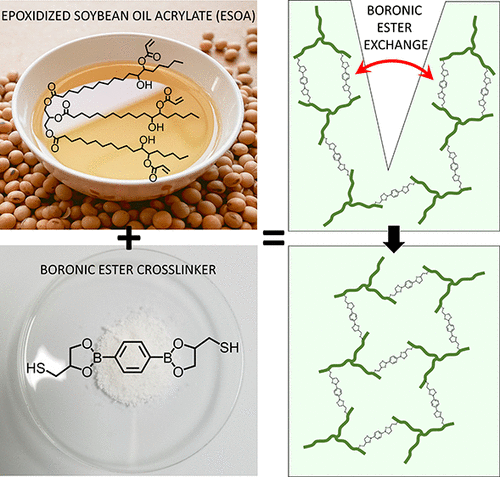当前位置:
X-MOL 学术
›
ACS Appl. Polym. Mater.
›
论文详情
Our official English website, www.x-mol.net, welcomes your
feedback! (Note: you will need to create a separate account there.)
Biobased, Biodegradable, Self-Healing Boronic Ester Vitrimers from Epoxidized Soybean Oil Acrylate
ACS Applied Polymer Materials ( IF 4.4 ) Pub Date : 2020-12-30 , DOI: 10.1021/acsapm.0c01335 Arkadiusz Zych 1 , Jonathan Tellers 2 , Laura Bertolacci 1 , Luca Ceseracciu 3 , Lara Marini 1 , Giorgio Mancini 1 , Athanassia Athanassiou 1
ACS Applied Polymer Materials ( IF 4.4 ) Pub Date : 2020-12-30 , DOI: 10.1021/acsapm.0c01335 Arkadiusz Zych 1 , Jonathan Tellers 2 , Laura Bertolacci 1 , Luca Ceseracciu 3 , Lara Marini 1 , Giorgio Mancini 1 , Athanassia Athanassiou 1
Affiliation

|
The global production of thermosets has been increasing in recent years causing rapid consumption of fossil-based feedstocks and contributing to the plastic waste accumulation in the environment, especially because they cannot be easily reprocessed or recycled at the end of their lifetime. These drawbacks can only be overcome with the development of environmentally friendly, recyclable thermosets from renewable resources. For this reason, we present a facile way to produce a biobased reprocessable thermoset, a vitrimer, by thiol-acrylate coupling between epoxidized soybean oil acrylate and a diboronic ester dithiol dynamic cross-linker. The synthesis of the cross-linker and all the processes for the production of the vitrimer has been done following green chemistry principles. The developed vitrimer material can be reprocessed multiple times like a thermoplastic, without compromising its mechanical properties. Moreover, it can be conveniently recycled by reversible hydrolysis in 90% ethanol and subsequent solvent evaporation, regenerating the original vitrimer. An important advantage of the developed material, especially regarding its applications, is that it is able to self-repair mechanical abrasion-related defects, like scratches and cuts, at room temperature, thanks to the low glass transition temperature and rapid boronic ester exchange, which enables it to demonstrate great potential as a self-healing coating. In case of an accidental release into the environment, it is able to biodegrade, solving the problem of waste accumulation.
中文翻译:

环氧大豆油丙烯酸酯的生物基,可生物降解,可自修复的硼酸酯微晶聚合物
近年来,热固性塑料的全球产量一直在增长,从而导致化石基原料的快速消费,并促进了塑料废物在环境中的积累,特别是因为它们在使用寿命结束时不容易进行再加工或回收。这些缺点只能通过使用可再生资源开发环保,可回收的热固性材料来克服。因此,我们提出了一种通过环氧化大豆油丙烯酸酯和二硼酸酯二硫醇动态交联剂之间的硫醇丙烯酸酯偶联来生产生物基可再加工的热固性陶瓷剂的简便方法。遵循绿色化学原理完成了交联剂的合成以及所有生产玻璃质单体的方法。可以像热塑性塑料一样对已开发的微粉化材料进行多次再加工,而不会影响其机械性能。此外,可通过在90%乙醇中可逆水解并随后蒸发溶剂,方便地将其回收,从而再生原始的vitrimer。研发材料的一项重要优势(尤其是在其应用方面)是由于较低的玻璃化转变温度和快速的硼酸酯交换能力,因此能够在室温下自修复与机械磨损相关的缺陷,例如划痕和割伤,这使其具有显示出自修复涂层的巨大潜力。万一意外释放到环境中,它可以生物降解,解决了废物堆积的问题。通过在90%乙醇中可逆水解并随后蒸发溶剂,可以方便地将其回收,从而再生出原始的vitrimer。研发材料的一项重要优势(尤其是在其应用方面)是由于较低的玻璃化转变温度和快速的硼酸酯交换能力,因此能够在室温下自修复与机械磨损相关的缺陷,例如划痕和割伤,这使其具有显示出自修复涂层的巨大潜力。万一意外释放到环境中,它可以生物降解,解决了废物堆积的问题。通过在90%乙醇中可逆水解并随后蒸发溶剂,可以方便地将其回收,从而再生出原始的三聚体。研发材料的一项重要优势(尤其是在其应用方面)是由于较低的玻璃化转变温度和快速的硼酸酯交换能力,因此能够在室温下自修复与机械磨损相关的缺陷,例如划痕和割伤,这使其具有显示出自修复涂层的巨大潜力。万一意外释放到环境中,它可以生物降解,解决了废物堆积的问题。它具有较低的玻璃化转变温度和快速的硼酸酯交换能力,因此能够在室温下自修复与机械磨损有关的缺陷,例如划痕和割伤,这使其具有自修复涂层的巨大潜力。万一意外释放到环境中,它可以生物降解,解决了废物堆积的问题。它具有较低的玻璃化转变温度和快速的硼酸酯交换能力,因此能够在室温下自修复与机械磨损有关的缺陷,例如划痕和割伤,这使其具有自修复涂层的巨大潜力。万一意外释放到环境中,它可以生物降解,解决了废物堆积的问题。
更新日期:2021-02-12
中文翻译:

环氧大豆油丙烯酸酯的生物基,可生物降解,可自修复的硼酸酯微晶聚合物
近年来,热固性塑料的全球产量一直在增长,从而导致化石基原料的快速消费,并促进了塑料废物在环境中的积累,特别是因为它们在使用寿命结束时不容易进行再加工或回收。这些缺点只能通过使用可再生资源开发环保,可回收的热固性材料来克服。因此,我们提出了一种通过环氧化大豆油丙烯酸酯和二硼酸酯二硫醇动态交联剂之间的硫醇丙烯酸酯偶联来生产生物基可再加工的热固性陶瓷剂的简便方法。遵循绿色化学原理完成了交联剂的合成以及所有生产玻璃质单体的方法。可以像热塑性塑料一样对已开发的微粉化材料进行多次再加工,而不会影响其机械性能。此外,可通过在90%乙醇中可逆水解并随后蒸发溶剂,方便地将其回收,从而再生原始的vitrimer。研发材料的一项重要优势(尤其是在其应用方面)是由于较低的玻璃化转变温度和快速的硼酸酯交换能力,因此能够在室温下自修复与机械磨损相关的缺陷,例如划痕和割伤,这使其具有显示出自修复涂层的巨大潜力。万一意外释放到环境中,它可以生物降解,解决了废物堆积的问题。通过在90%乙醇中可逆水解并随后蒸发溶剂,可以方便地将其回收,从而再生出原始的vitrimer。研发材料的一项重要优势(尤其是在其应用方面)是由于较低的玻璃化转变温度和快速的硼酸酯交换能力,因此能够在室温下自修复与机械磨损相关的缺陷,例如划痕和割伤,这使其具有显示出自修复涂层的巨大潜力。万一意外释放到环境中,它可以生物降解,解决了废物堆积的问题。通过在90%乙醇中可逆水解并随后蒸发溶剂,可以方便地将其回收,从而再生出原始的三聚体。研发材料的一项重要优势(尤其是在其应用方面)是由于较低的玻璃化转变温度和快速的硼酸酯交换能力,因此能够在室温下自修复与机械磨损相关的缺陷,例如划痕和割伤,这使其具有显示出自修复涂层的巨大潜力。万一意外释放到环境中,它可以生物降解,解决了废物堆积的问题。它具有较低的玻璃化转变温度和快速的硼酸酯交换能力,因此能够在室温下自修复与机械磨损有关的缺陷,例如划痕和割伤,这使其具有自修复涂层的巨大潜力。万一意外释放到环境中,它可以生物降解,解决了废物堆积的问题。它具有较低的玻璃化转变温度和快速的硼酸酯交换能力,因此能够在室温下自修复与机械磨损有关的缺陷,例如划痕和割伤,这使其具有自修复涂层的巨大潜力。万一意外释放到环境中,它可以生物降解,解决了废物堆积的问题。















































 京公网安备 11010802027423号
京公网安备 11010802027423号